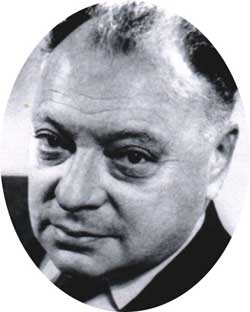Wolfgang Pauli is one of the prominent scientific figures of the 20th century. His contributions to atomic structure played a decisive role in establishing quantum theory.
 |
Scientist Wolfgang Pauli |
At the time of Wolfgang Pauli’s birth in Vienna in 1900, the capital of the Austro-Hungarian Empire was still the heart of European intellectual life: physicist Ludwig Boltzmann was studying music at Bruckner’s home while Schönberg was creating twelve-tone music, Freud was introducing psychoanalysis, and Wittgenstein was making the profound language of philosophy accessible to the public.
As a natural sciences student, the young Pauli quickly became a prodigy in physics and mathematics. His godfather, Ernst Mach, along with Pauli’s father, both professors at the University of Vienna, supported him greatly in his studies. At that time, Mach was already a well-known figure in supersonic aerodynamics, and his critiques of the foundations of physics attracted considerable attention. Particularly, his concepts of absolute space had a decisive influence on Einstein’s Special Theory of Relativity (1905) and General Theory of Relativity (1915).
After a series of critiques on relativity, including three papers published in 1919 and a lengthy 250-page encyclopedic article in 1921, the young Austrian was welcomed by Einstein himself. Subsequently, Einstein even regarded Pauli as “the heir” (wahl Sohn). The path ahead of Pauli was wide open, and in 1918, he joined the class of physicist Arnold Sommerfeld.
At that time, Sommerfeld was researching the “global model” of the atom discovered in 1910 through the work of Ernest Rutherford: nearly all mass concentrated in a nucleus, about one-millionth of a billionth of a meter in diameter, around which light charges orbited like planets around the sun. In 1913, Bohr demonstrated that the emission or absorption properties of light from an atom could be explained by hypothesizing borrowed electric particles, among the countless detectable orbits thanks to the technology of that era, with some static orbits defined by all named orbits. It was stated that electric orbits could be “quantized” and required three numbers (in three-dimensional space) to describe them. As it moved from one static orbit to another, the electric charge would lose or absorb energy in the form of light.
Experiments demonstrated that the light absorbed or emitted was influenced by the presence of a magnetic field. To explain this result, Pauli calculated the oscillations affected by magnetic fields for each quantized orbit. During the winters of 1921-1922, he worked in Göttingen and then moved to Copenhagen in December 1924. It was a long journey through a desert for which the prodigious boy was unprepared. However, he managed to observe effects while using two rules. According to the first rule, the static state of an electric particle cannot be defined by three but rather four numbers, with values of -1/2 or +1/2. The second rule, known as the “exclusion principle”, clearly states that a state can only be occupied by one electric particle at a time. This discovery of the principle earned him the Nobel Prize in Physics in 1945.
Pauli remarked that, for the first rule, the electric particle already possesses “an indescribable duality (Zweideutigkeit)”. So what is the direction of the fourth number? Originating from the global image, Lars Kronig, Pauli’s assistant in 1924, suggested that the electric particle spins around itself like a top and also rotates around the central nucleus. Thanks to this quantifiable hypothesis, the fourth number emerged. However, Pauli prevented Kronig from publishing this.
Using analogy, it was shown that in fact, the top only spins halfway. When it spins 360o, the state of the electric particle changes sign. It requires 720o for it to return to its original position.
This image was so compelling that in 1925, two Dutch scientists, George Uhlenbeck and Samuel Goudsmit, named this angular momentum property of the electric particle “spin.” According to them, spin corresponds to the fourth quantum number. This name was retained, but in 1926, Kronig commented in Nature: “The new hypothesis has pushed the ghost down to the basement of the family house instead of throwing it out of the house permanently.”
Pauli condemned the spinning top idea right from the start because he no longer believed in the manifestations of atomic processes. From the inception of the exclusion principle, he wrote to Niels Bohr, stating that the quantum numbers seemed to him “much more real in relation to the orbits.” This observation was later utilized by Heisenberg and the Göttingen research team to develop quantum mechanics.
In the following years, in Zurich—where he moved in 1928, Pauli participated in the development of a new mechanics, which puzzled many physicists due to its methods and expressions. On one hand, the tight causal relationship of a physical process (deterministic theory) replaced static causal relationships, where a single process could only be described in probabilistic terms. On the other hand, description could only proceed by specifying the situations in which the process was observed. The method of evaluating physical reality achieved empirical success but was also rejected by a small number of physicists, including Einstein.
After becoming a German citizen, Pauli still had to leave Zurich for America during the years 1940-1945 due to the reason that “his ancestors had up to 75% Jewish blood.” There, while working on theories of independent spin molecules, he contemplated transforming the foundations, as Heisenberg called it, “the moral decay of materialism” stemming from Democritus’s atomic theory and Newton’s mechanics of motion. Matter could be viewed as a collection of colliding particles, much like billiard balls. Pauli went against the formative period of ontology, specifically at the beginning of the 17th century, when Johannes Kepler discovered the laws of celestial mechanics.
Pauli discovered that Kepler’s natural explanations were often associated with “archetypes” to be easily accepted. Particularly from the idea that natural numbers are an archetype of the world, Kepler inferred that natural explanations must be quantified, a thought that haunted him from the very beginning. As a result, a debate occurred between him and the alchemist Fludd, who firmly believed that nature must be interpreted qualitatively. This was the “great clash between the mystical thinking of alchemy and the emerging natural science thinking (which appeared in the early 17th century). Recent studies have reaffirmed the contradictory transition between these two ways of thinking.
The success of Kepler’s steps and those of his successors directed physics toward a more natural mechanical conception. This conception was later linked to the idea of observation with physical processes: a phenomenon can, in principle, be described without reference to human observation. However, atomic physics demonstrated that the description of a process cannot be derived from any observation. Pauli’s conclusion: “In the 17th century, significant progress was made” in the conception of mechanics.




















































